Table of contents
- Honda all-wheel drive electric patent Honda charges through the front wheel
- Honda drives all the wheels
- Conclusion
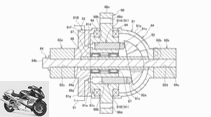
Honda
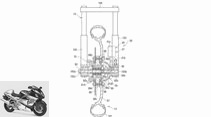


3 pictures
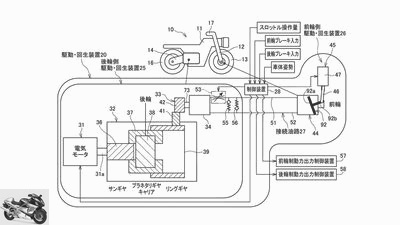
Honda
1/3
Honda is probably planning to use front-wheel drive to increase the potential of generating braking energy in electric drives.
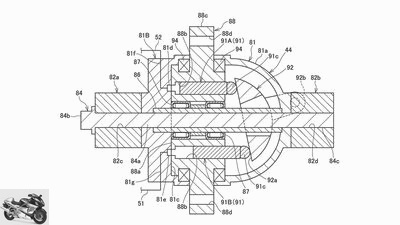
Honda
2/3
For this purpose, a pump is driven by the electric motor, which hydro-mechanically drives the front wheel.

Honda
3/3
When braking, the counter pressure of the hydraulics ensures constant braking torque on the electric motor, which can then efficiently generate electricity.
counselor
technology & future
Honda patent: all-wheel drive to generate electricity
Honda all-wheel drive electric patent
Honda charges through the front wheel
Honda deals with the topic of energy recovery when braking an electric motorcycle or scooter. All-wheel drive should generate more electricity and thus offer more range.
Jens Kratschmar
06/29/2021
The subject of all-wheel drive for two-wheelers is as old as the concept itself. The problem: the individual track of the motorcycle requires a change in the direction of rotation, i.e. some type of transmission. In addition, the swiveling front wheel needs a drive that does not prevent the steering angle or driving dynamics properties. These components all add weight and the driving force on the wheel increases the steering forces. The solution: no all-wheel drive for motorcycles in series. Here and there an experiment or a small series, but nothing tangible. Honda is probably thinking about equipping electric motorcycles with hydraulic front-wheel drive, primarily to use the additional braking energy to charge the battery.
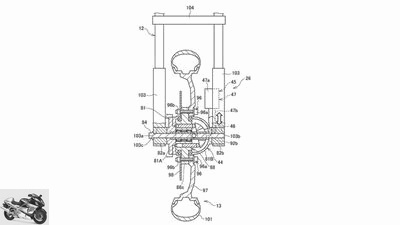
Honda
When braking, the counter pressure of the hydraulics ensures constant braking torque on the electric motor, which can then efficiently generate electricity.
Honda drives all the wheels
When braking or coasting, the electric motor short-circuits into an optional generator and produces electricity. The problem: With high braking forces, the dynamic wheel load distribution relieves the rear wheel, which lowers the braking torque of the electric motor and, in the worst case, completely prevents recuperation to avoid wheel blockage. Honda has therefore worked on a hydraulic drive for the front wheel that allows the generator to generate electricity continuously when pushing or braking. For this purpose, a drive shaft is moved by hydraulics in the wheel hub and a mechanism that turns the wheel is probably driven by a Pinion drive. In the opposite case, i.e. when braking or rolling, the mechanics generate counter pressure in the hydraulics, which then permanently supply the electric motor with braking torque to generate electricity.
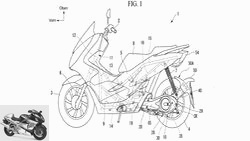
Electric
Honda rolls electrically
Electric scooter with changing system confirmed
read more
Conclusion
Yes and no. Yes: When it comes to electric, the two-wheeler has the disadvantage that the driven wheel is the one with the weakest brakes. The electric motor can only generate electricity inefficiently when braking. Honda wants to counter-steer this with an additional, possibly alone-driven wheel and generate a lot of electricity through high wheel loads. No: it won’t go into series production anytime soon.
Related articles
-
Bosch patent for electric motor with ABS: brake charges battery
Bosch counselor technology & future Bosch patent for electric motor with ABS: brake charges battery Bosch patent for electric motor with ABS Brake…
-
Honda patent new sports clutch: Clutch-by-Wire
Honda 8th pictures Honda 1/8 Honda’s invention addresses the technical compromise of the anti-hopping clutch and adds a semi-automatic system to the…
-
Patent for electric Honda: batteries to change
Honda 4th pictures Honda 1/4 A tubular steel frame forms the backbone of the new electric Honda scooter, the motor sits in the swing arm, the two…
-
Honda compressor patent: series twin with supercharging
Honda 5 pictures Honda 1/5 Honda has combined the Africa Twin’s in-line twin with a supercharger in a patent specification. Honda 2/5 The twin screw…
-
Michelin patent: friction wheel drive as a maneuvering aid
Michelin 6th pictures Michelin 1/6 Tire manufacturer Michelin has patented an electric maneuvering aid for motorcycles. Michelin 2/6 The compact unit…
-
Patent: Harley wants to adaptively drive in a convoy
Harley-Davidson 4th pictures Harley-Davidson 1/4 Using GPS tracking, motorcycles with adaptive cruise control should receive more precise speed…
-
Honda patent: drone as a dinghy
Honda 5 pictures Honda 1/5 Honda has patented a system in the USA in which an electric motorcycle works together with a drone. Honda 2/5 The drone itself…
-
Honda plans rear spoiler: patent for ventilated rear
Honda 5 pictures Honda 1/5 Honda has patented a wing element for the rear of the motorcycle. Honda 2/5 The two-wing spoiler element comes with a…
-
fact 16 pictures archive 1/16 The primary drive and clutch shovel the mountains of torque from the crankshaft to the gearbox. A task that can only be…
-
Suzuki electric scooter patent: electric and air-cooled
Suzuki Motorcycles 4th pictures Suzuki Motorcycles 1/4 This is what the Suzuki electric scooter could look like. Drive probably via chain or belt,…